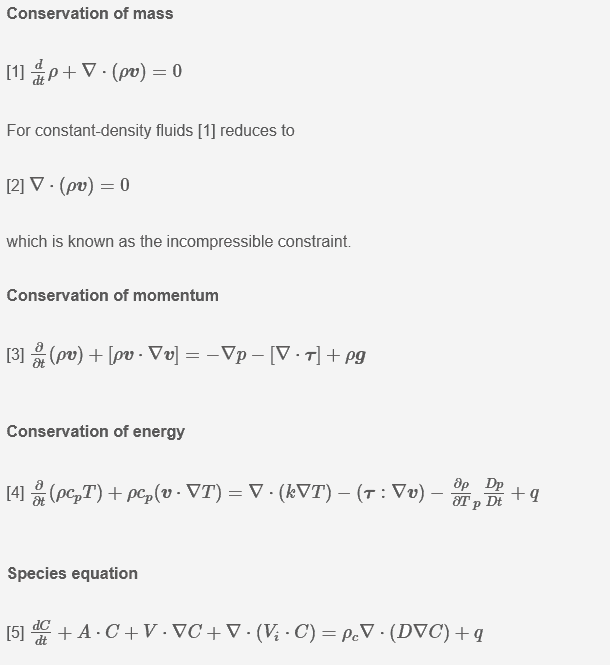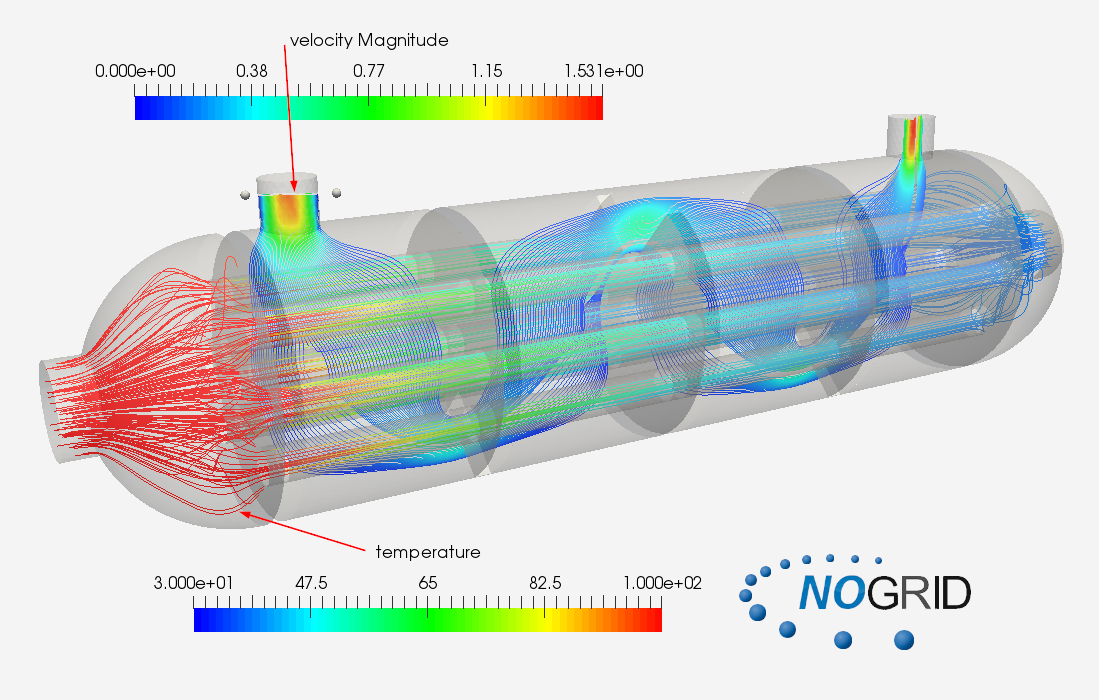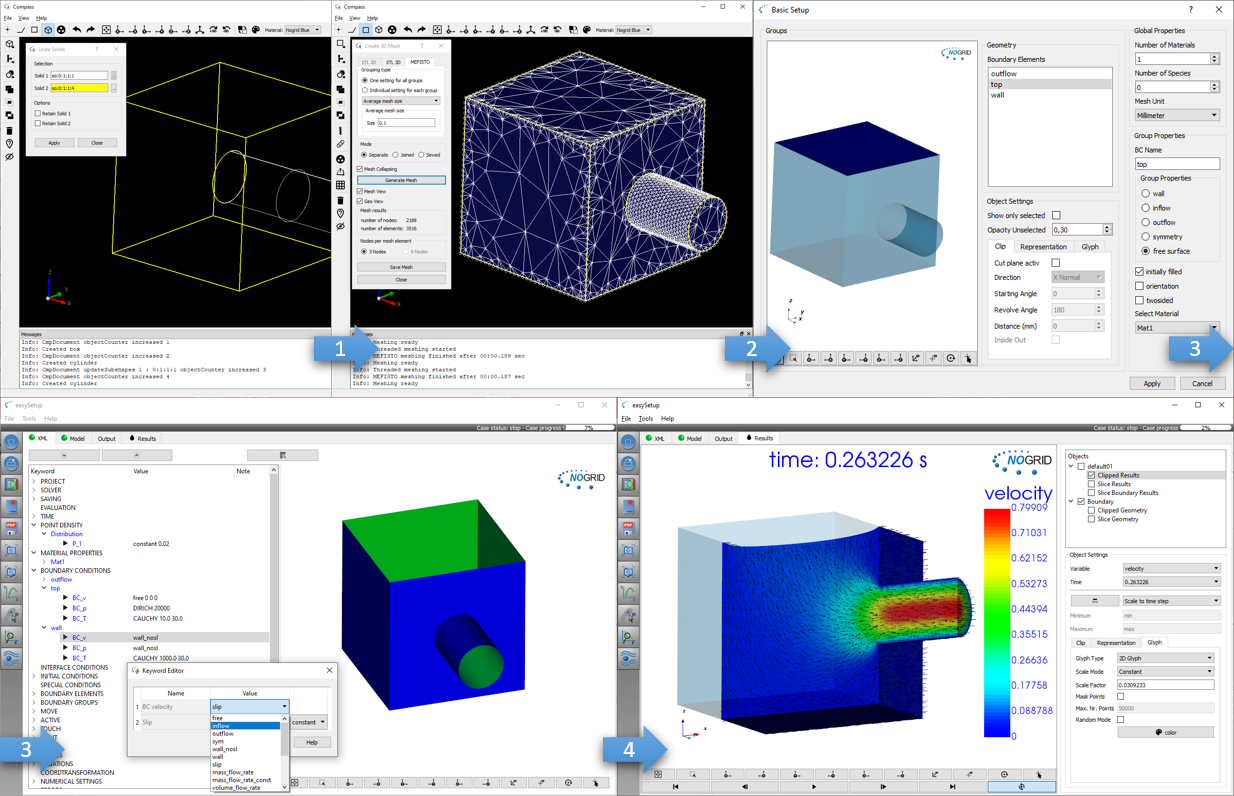How to Start with CFD Simulation
Computational Fluid Dynamics for Beginners
Introduction to CFD Simulation
CFD simulation, or Computational Fluid Dynamics simulation, is a powerful tool that allows engineers to analyze fluid flow and other phenomena using numerical methods. The question how to start computing fluid mechanic cases is not really complicated if you use the CFD simulation software from NOGRID. CFD is a branch of fluid mechanics that uses numerical analysis to solve problems that involve fluid flows. Computers are used to perform the computations required using CFD simulation software to simulate the interaction of the fluid with boundaries defined by initial and boundary conditions. Fluid mechanics is the science that studies the physical behavior of fluids which are mathematically stated through differential equations, the Navier-Stokes equations.
Understand the Basics of CFD Simulations: Navier-Stokes equations
The fundamental basis of almost all CFD simulation problems are the Navier–Stokes equations which are a statement of the balance of momentum, but sometimes the equations for conservation of mass and the balance of energy are added.
In order to solve the Navier–Stokes equations the fluid domain must be discretized, which means the volume occupied by the fluid is divided into discrete cells (the mesh). The Finite Volume Method (FVM) is a common approach used in CFD codes, as it has an advantage in memory usage and solution speed, especially for large problems, high Reynolds number turbulent flows, and source term dominated flows (like combustion). The Finite Element Method (FEM) is used in structural analysis of solids, but is also applicable to fluids. The Finite Difference Method (FDM) has historical importance and is easy to implement. It is currently only used in a few specialized codes, which handle complex geometry with high accuracy and efficiency.

CFD simulation software from NOGRID
NOGRID points CFD software, based on an innovative meshless technology, is a software package for simulation tasks in the wide area of flow and continuum mechanical problems. The fluid dynamics program doesn't only solve fluid flows, but also problems with elastic or plastic deformations. More generally spoken, NOGRID points considers all the viscous as well as elastic/plastic stress tensors, and any mixture of it.
NOGRID points does not require a grid or mesh, in contrast to software products based on classical numerical methods, such as Finite Elements or Finite Volumes, where the generation of meshes takes a long time. NOGRID points can excellently be applied in case of all problems, where grid-based methods reach their limits due to the necessary remeshing. The CFD simulation software is based on one of the latest technologies in the area of numerical flow simulation.

Steps to introduce CFD Simulation Software in your Company
Introducing CFD simulation software within a company requires very often some pre-arrangements. As users know, a lot of parameters and conditions affect the final product features and their quality. For example if the fluid viscosity is not known exactly, the results of the simulation can vary a lot.
The same is valid for the initial conditions. From practical point of view it is very often not possible to measure the initial temperature of a fluid completely. Companies try to measure the temperature in research projects, but the measured temperature fluctuates very often (especially in the glass industry).
For all these reasons the engineer has to make assumptions for the simulation and prove and adapt the simulation results by experiment.
There are usually three steps required to introduce the CFD simulation software in your company:
- Proof-of-concept phase
- Pilot phase
- Production phase
Step 1: Start with a Proof-of-Concept in CFD Simulation
One of the ways to do a proof-of-concept is to create a benchmark and compute this benchmark with the new simulation tool. The number of benchmark variations to be investigated in this phase depends on the industry, but should not be less than 3. Due to the complex physics in each industry certainly more tests are required. In this first phase, the simulation tool is used on a small scale, with sufficient time to explore different ways in which it can be used. For this proof-of-concept phase, objectives should be set to meet the requirements in the current organizational context.
Step 2: Conduct a Pilot Phase for CFD Simulation
In the second phase one or more qualified designers/engineers start to evaluate the simulation software in the in-house production environment. Users attempt to find the best agreement between experiment and simulation:
- Measure all experimental data available for the production case or benchmark.
- Compute the process by adapting the properties and the conditions until you reach best agreement between simulation and reality.
Then the user can start to change the product design or the real process conditions and prove it by simulation. If a good agreement is found also for the new benchmark, then the simulation was successful and should be able to correctly predict future product/production changes.
Most unknown conditions and properties are found in this pilot phase. Furthermore a pilot phase is expected to have issues or problems – they should be resolved in a way that can be used by everyone later. The pilot project should experiment with all kinds of different products at different locations in order to include all possible conditions within the settings. The objectives for a pilot project for a new tool are:
- To learn more about the tool in detail and estimate and evaluate unknown conditions and material properties
- To see how the tool fits the real process
- To decide on standard ways of using the tool that will work for all potential users
- To evaluate the pilot project with regard to its objectives (were the benefits achieved at reasonable cost?)
Step 3: Transition to Full-Scale CFD Simulation in Production
Once the pilot phase is successfully completed, the third phase – the production phase - can finally begin. In this phase the software is made available to all designers/engineers in order to optimize a product or process or simply to check if a new product is causing difficulties or just works well without having to do anything before production.
Nogrid's strengths

Easy and fast modelling: Build geometry, mesh boundary, setup the case and start computation
What is CFD from NOGRID?
CFD solves the fundamental equations that define the fluid flow process. With CFD software from NOGRID every engineer makes better decisions by predicting, analyzing and controlling fluid flow, heat and mass transfer or chemical reaction. By using NOGRID software for flow modeling you receive information on essential flow characteristics as for example flow distribution. Using it additional to testing and experimentation NOGRID software helps to improve the evaluation of your design – resulting in better construction and operation parameters, increasing planning security and money savings due to faster time to the marketplace for your product or process.
Choose NOGRID
With NOGRID, you choose professional CFD software and services – our aim is helping you to be successful. When you decide to work with NOGRID you choose close cooperation with a dynamic, flat hierarchies-organization. Short information channels result in quick and accurate professional support and service. Our team consists of highly qualified employees, who are experts in fields such as numerical simulation or computational fluid dynamics. Based on our know-how, we are pleased to offer the following services, responding to your individual requirements:
TRAINING
In our two-days training courses you will learn, how to use NOGRID CFD software efficiently. Our technical support team will teach you how to handle and solve different cases.
For more details please refer to Training Courses →
Technical Support
We offer full professional support from the minute you start using our software, by telephone or by email. Contact us, when ever needed.
For more details please refer to Software Support →
Service
Lack of time or resources and other constraints often make outsourcing an attractive solution. We help you with your flow modeling needs. Based on our engineering expertise in this field we offer individual numerical simulation services matching the unique needs of your organization.
For more details please refer to Simulation Services →
About Us
Simulation Software from Nogrid
Follow Us:
